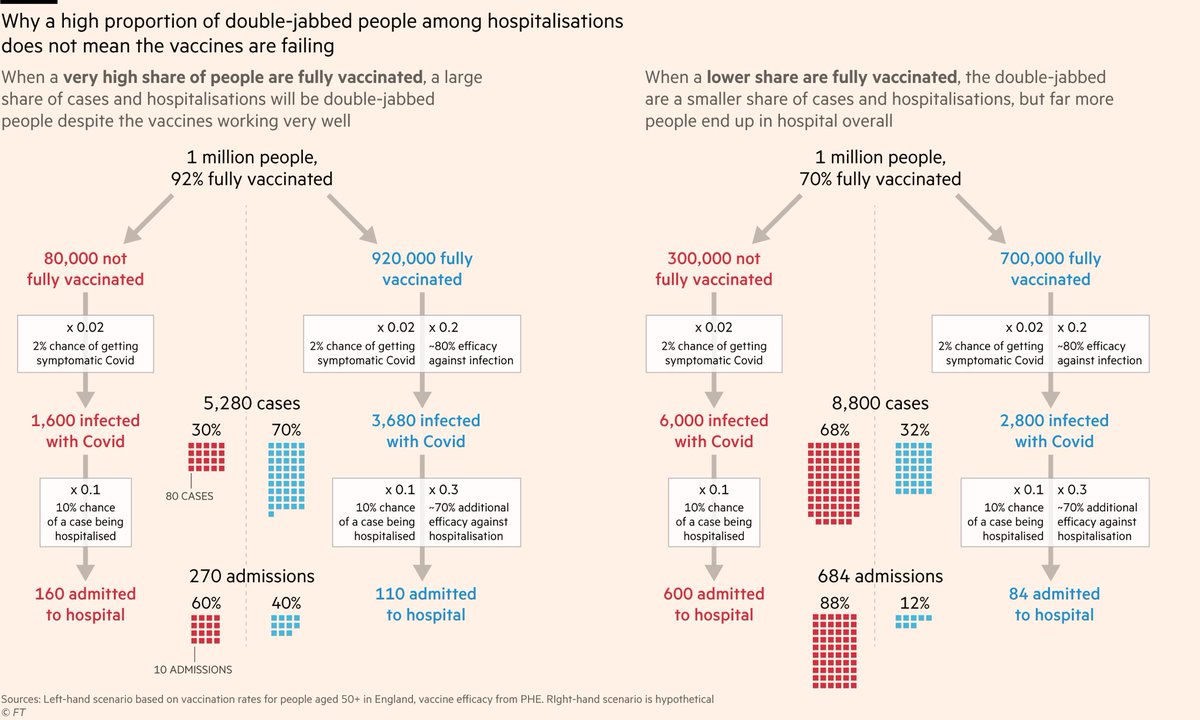
NEW: lots of news recently on waning immunity against infection, but a study has now landed from Public Health England on how vaccines are faring against *severe disease & death*
This chart summarises key findings, but the paper is a real goldmine, so let’s dig into more detail:
This chart summarises key findings, but the paper is a real goldmine, so let’s dig into more detail:

First up, fresh data on protection against symptomatic infection. Key results:
• We knew protection started out lower among older groups. Now we know they also see the most waning
• Waning much more muted (if happening at all) among under-65s
• Moderna > Pfizer > AstraZeneca
• We knew protection started out lower among older groups. Now we know they also see the most waning
• Waning much more muted (if happening at all) among under-65s
• Moderna > Pfizer > AstraZeneca
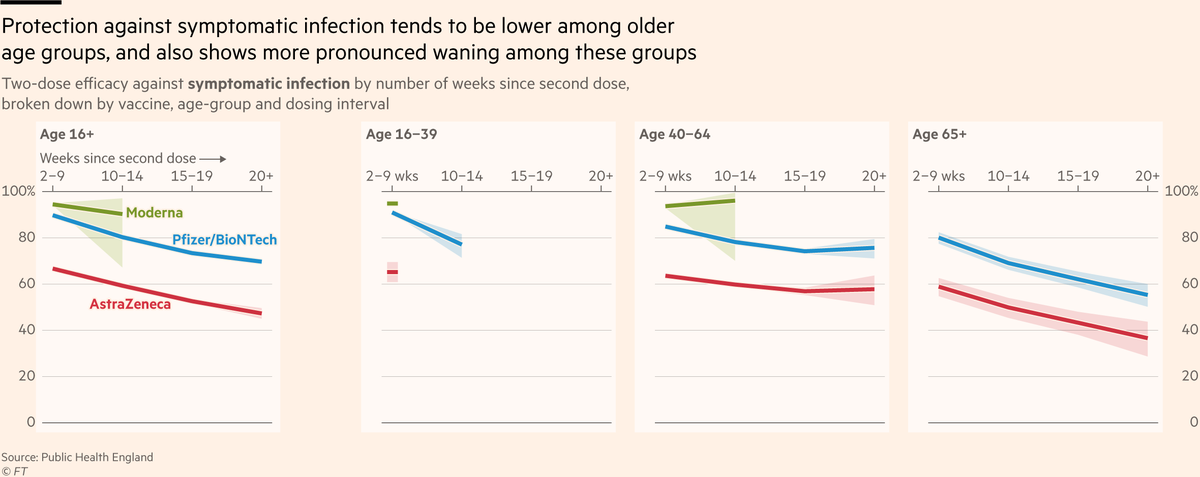
Sticking with symptomatic infection, they also looked at a hot topic: the impact of the interval between first and second dose
Very short intervals (3 weeks, e.g in US) produce lower protection than longer intervals (e.g UK & Canada), though note overlapping confidence intervals
Very short intervals (3 weeks, e.g in US) produce lower protection than longer intervals (e.g UK & Canada), though note overlapping confidence intervals
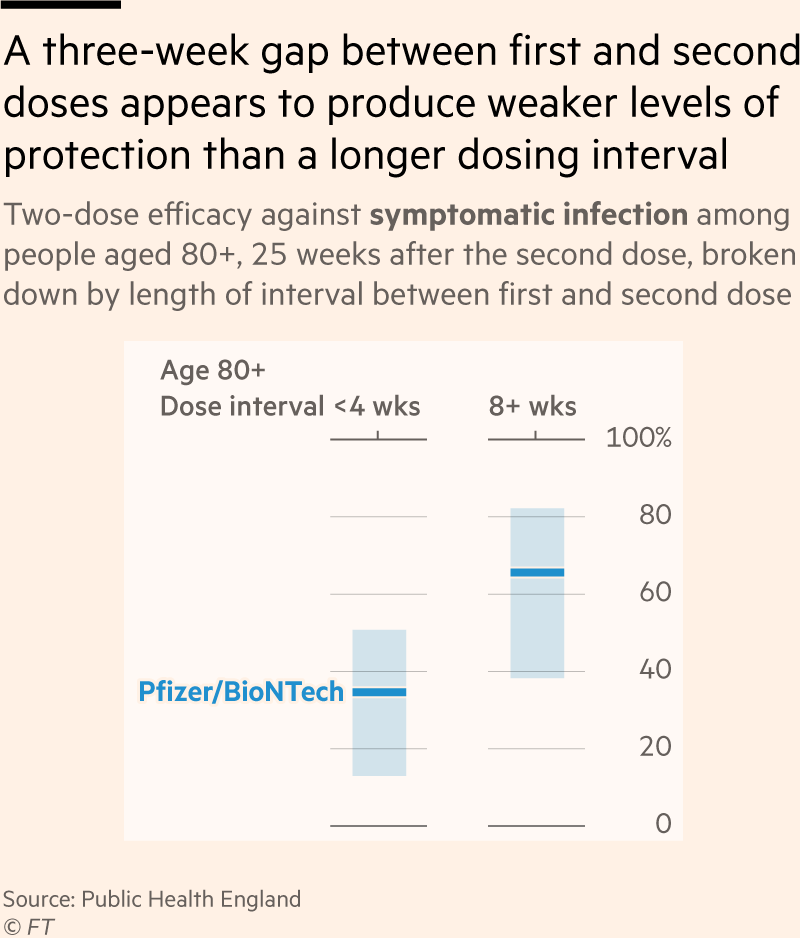
Now protection against hospitalisation:
• Much higher than against infection 💪
• Pfizer shows very little waning apart from in very elderly
• AZ shows slight waning, but still holds up well at 80%+ for adults after 5 months (and note big conf ints around the last 40-64 point)
• Much higher than against infection 💪
• Pfizer shows very little waning apart from in very elderly
• AZ shows slight waning, but still holds up well at 80%+ for adults after 5 months (and note big conf ints around the last 40-64 point)
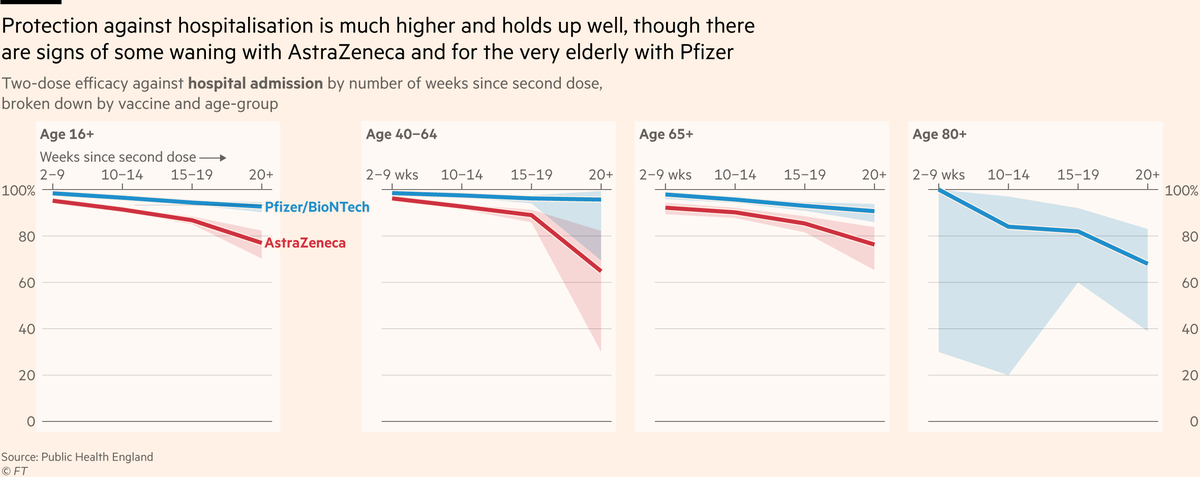
And crucially, the study also breaks down protection against hospitalisation by underlying health conditions, which brings us to a key finding:
• Among those without severe comorbidities, there is actually very little waning against severe disease, if any. Both for Pfizer and AZ
• Among those without severe comorbidities, there is actually very little waning against severe disease, if any. Both for Pfizer and AZ

Even among over-65s, if you don’t have severe underlying conditions, you still get somewhere between 80% protection (AZ) and 95% (Pfizer) relative to an unvaccinated person even 5 months after your second shot.
Finally, the researchers looked at efficacy against death, and again the results are good news.
• Very little waning for Pfizer, even among elderly
• Only modest waning for AZ, and still 80% protection at 5-months-plus since second dose
• Very little waning for Pfizer, even among elderly
• Only modest waning for AZ, and still 80% protection at 5-months-plus since second dose
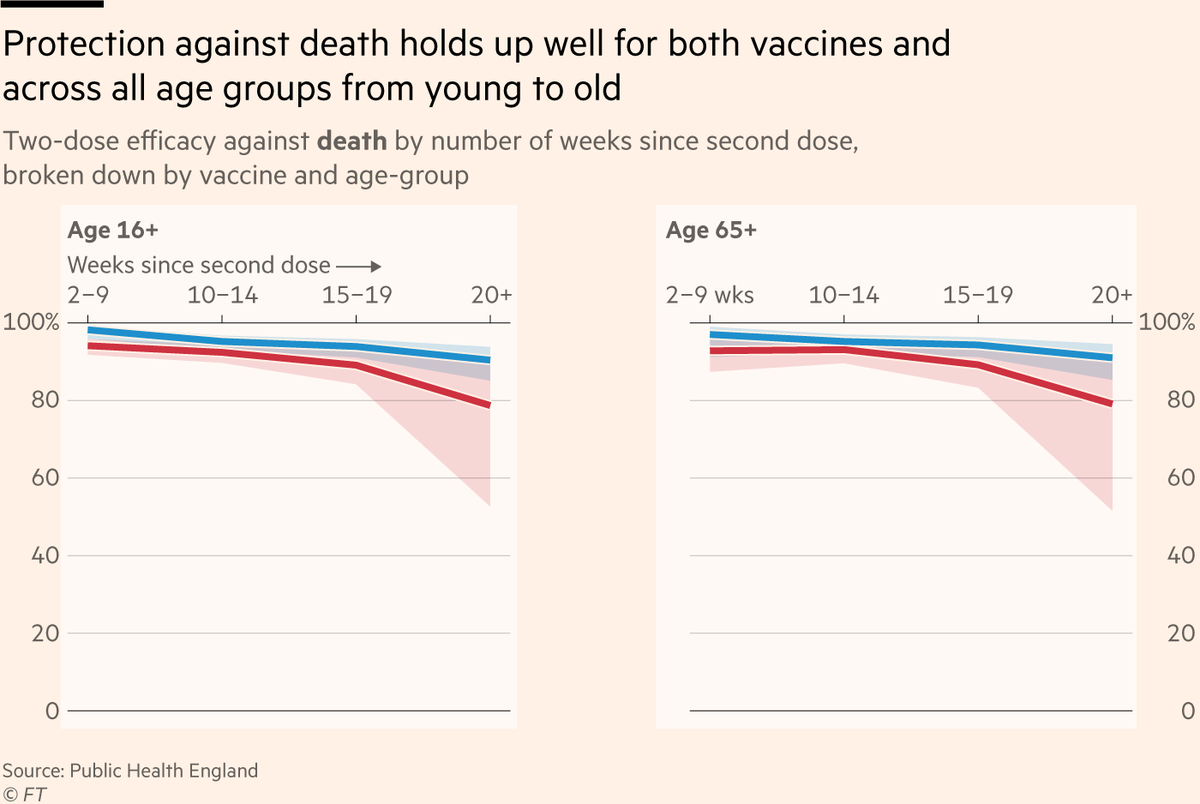
Here’s the full preprint paper khub.net/documents/1359…
I’ve also transcribed as much of the data as I could from the tables in the paper, in case that’s of use to people (please tell me if you spot a transcribing error!): docs.google.com/spreadsheets/d…
I’ve also transcribed as much of the data as I could from the tables in the paper, in case that’s of use to people (please tell me if you spot a transcribing error!): docs.google.com/spreadsheets/d…

Now onto the broader discussion:
• We can clearly see that not everyone needs a booster. For most under-65s, and even some healthy over-65s, protection is still holding up very well
• But for those with serious underlying health conditions, boosters could make a big difference
• We can clearly see that not everyone needs a booster. For most under-65s, and even some healthy over-65s, protection is still holding up very well
• But for those with serious underlying health conditions, boosters could make a big difference
On that topic, what do we know about how boosters themselves are working?
For that we can turn to Israel, where the data looks very promising...
For that we can turn to Israel, where the data looks very promising...
• By Jul/Aug, waning against infection meant case rates among over-60s were almost as high among double-jabbed as un-jabbed
• But rates now plummeting among boosted cohort
• 2-dose protection was still solid against severe outcomes, but boosters have strengthened it regardless
• But rates now plummeting among boosted cohort
• 2-dose protection was still solid against severe outcomes, but boosters have strengthened it regardless
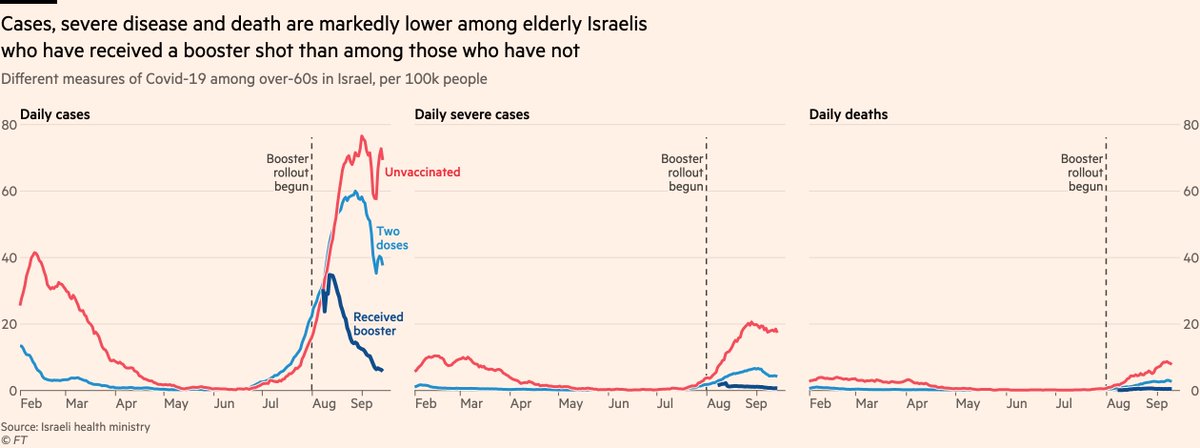
Other things to note:
• Israel may have had a bigger waning problem than e.g the UK because of its shorter dosing interval. PHE paper would support that theory
• Similarly, short dosing interval may be a factor in how bad US’s Delta wave has been (tho low US vax rates also key)
• Israel may have had a bigger waning problem than e.g the UK because of its shorter dosing interval. PHE paper would support that theory
• Similarly, short dosing interval may be a factor in how bad US’s Delta wave has been (tho low US vax rates also key)
Recent data from Israel compares protection from a booster shot to a range of other scenarios including protection from infection (both along and on top of vaccine):
https://twitter.com/andrewlilley_au/status/1435850463237193732
This is important for two reasons:
• First, it shows infection-acquired immunity plays an important role in protecting a population from the virus (but no: don’t go out and try to get infected)
• First, it shows infection-acquired immunity plays an important role in protecting a population from the virus (but no: don’t go out and try to get infected)
• Second, it’s critical to remember that if a VE study doesn’t make sure its unvaccinated control group have all never been infected, its estimate of vaccine-induced protection will be biased downwards because of the level of protection that previously-infected people have
And on that note, the always-excellent @mugecevik has a fantastic diagram here demonstrating how the more time passes, the more ways there are that estimates of vaccine efficacy can be biased (in both directions), which is always worth keeping in mind
https://twitter.com/mugecevik/status/1430218388287148035
To conclude:
• Most people, especially younger adults and people in good health still have excellent protection against severe Covid, and do not urgently need boosters
• Boosters could save the lives of many older and otherwise vulnerable people (and reduce hospital pressure)
• Most people, especially younger adults and people in good health still have excellent protection against severe Covid, and do not urgently need boosters
• Boosters could save the lives of many older and otherwise vulnerable people (and reduce hospital pressure)
One side-note:
I’ve talked a lot about how the rush for boosters in rich countries feels ethically dubious given the number of developing countries still seeing record death tolls [in their largely unvaccinated populations]
I still hold that view, but...
I’ve talked a lot about how the rush for boosters in rich countries feels ethically dubious given the number of developing countries still seeing record death tolls [in their largely unvaccinated populations]
https://twitter.com/jburnmurdoch/status/1429878268669399044
I still hold that view, but...
Now with two injections (sorry) of nuance:
1) I don’t think it’s helpful to think of vaccine supply as a zero-sum game. Vaccine manufacturers respond to demand, and it’s not as simple as booster doses being diverted from Africa
1) I don’t think it’s helpful to think of vaccine supply as a zero-sum game. Vaccine manufacturers respond to demand, and it’s not as simple as booster doses being diverted from Africa
2) Vax supply (and uptake) in developing world is not straightforward. Huge part of it *is* about wealthy countries buying and donating doses to less fortunate. But it’s also a thorny logistics question, and I don’t think we spend enough time & energy addressing that.
Addition to thread on protection vs severe disease:
As Jeremy notes here, doesnt look like any of waning slopes for severe disease are steeper than slopes for infection, meaning protection against severe disease *once infected* may not be waning at all...
As Jeremy notes here, doesnt look like any of waning slopes for severe disease are steeper than slopes for infection, meaning protection against severe disease *once infected* may not be waning at all...
https://twitter.com/jeremyfaust/status/1437892040877088771
...it could just be that as protection against infection wanes, a constant rate of protection vs severe disease once infected shows up as a waning against severe disease too (though there are different schools of thought on how the two interact)
https://twitter.com/jburnmurdoch/status/1429878252470931460
• • •
Missing some Tweet in this thread? You can try to
force a refresh






